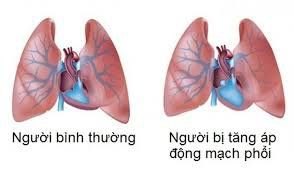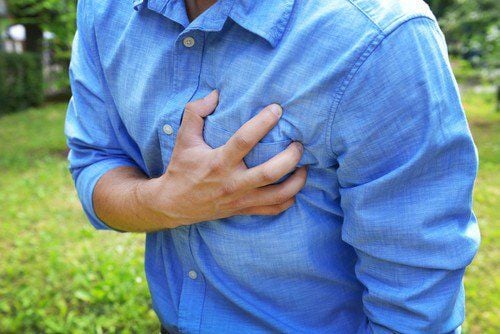This is an automatically translated article.
The article is professionally consulted by Master, Doctor Do Xuan Chien and Master, Doctor Hoang Thi Hoa - Department of Medical Examination and Internal Medicine - Vinmec Ha Long International General Hospital.Pulmonary hypertension is an abnormal increase in pressure in the pulmonary arteries. This is a very dangerous disease, if not treated in time the disease can cause very serious complications and the risk of death. The treatment regimens for pulmonary hypertension along with new drugs have been put into use to help increase the effectiveness of treatment and the quality of life of patients.
1. What is pulmonary hypertension?
Normal pulmonary artery pressure is 15-20 mmHg. Pulmonary hypertension occurs when the blood pressure in the pulmonary artery at rest is ≥ 25 mmHg and at exercise ≥ 30 mmHg.Disease in the early stages often has no specific symptoms or symptoms are very mild, often overlooked. When symptoms such as shortness of breath, fatigue, chest pain, coughing up blood, leg edema, fainting, etc., the disease is usually in a severe stage.
Pulmonary hypertension includes primary pulmonary hypertension (IPH), which is pulmonary hypertension with no known cause, and secondary pulmonary hypertension, which is pulmonary hypertension caused by some diseases such as: pulmonary embolism (blood clot in the lungs), chronic obstructive pulmonary diseases, congenital heart disease, heart failure, connective tissue disorders such as lupus erythematosus, AIDS,...
Increase Pulmonary arterial pressure, if not treated aggressively and eliminated the causes of the disease, can cause dangerous complications such as:
Causes right heart failure, often severe prognosis and leads to death; Increases the likelihood of blood clots forming in the pulmonary arteries, causing pulmonary infarction, if the clots cause narrowing or occlusion of large blood vessels, shock and death can occur. Causes cardiac arrhythmias; Coughing up blood and bleeding in the lungs, this is a serious complication that threatens the patient's life.

2. Treatment regimen for pulmonary hypertension
2.1. Supportive treatment Rest, avoid exertion, avoid stress; Oral anticoagulants: Initial dose of warfarin is 1 mg/day, dose adjusted accordingly for each patient. Anticoagulation should be indicated in all patients with pulmonary hypertension; Diuretics: When using diuretics, pay attention to monitor kidney function, blood count to avoid the risk of kidney failure. The following diuretics can be used: Furosemide; Furosemide combined with anti-aldosterone diuretics such as Spironolactone; Idapamide. When arterial oxygen specific pressure (PaO2) <60mmHg or SpO2>90%, give the patient continuous oxygen; Cardiac glycosides such as Digoxin, which increase cardiac output, however, when used for a long time, the effect is unknown; If arrhythmia is present, treat with antiarrhythmic drugs. 2.2 Treatment of causes of pulmonary hypertension Treatment of diseases causing secondary pulmonary hypertension.
Usually indicated in primary pulmonary hypertension; Commonly used drugs are: Nifedipine, Diltiazem, Amlodipine; Adjust the dose to suit each patient's response, the patient's blood pressure must be measured from the second dose onwards. Pay attention to the side effects of calcium blockers such as ankle edema, headache, dizziness, palpitations,... Phosphodiesterase-5 enzyme inhibitor group:
Usually indicated for patients with arterial hypertension lungs with dyspnea (NYHA II, III); Drugs used: Sildenafil initial dose 25mg x 3 times/day, adjust dose according to patient response; The effect of improving the patient's symptoms and exercise capacity. A common side effect is headache. Do not administer to patients taking citrate. Group of endotheline receptor antagonists:
Commonly used drugs: Bosentan, dose 62.5mg x 2 times/day in the first month, adjust the dose in the next month to suit the patient; The drug helps to improve symptoms and exercise tolerance, when used, it is necessary to monitor liver function. Contraindicated in patients being treated with cyclosporin or glyburide. Prostacyclin class:
Epoprostenol: For patients with severe pulmonary hypertension (NYHA class III or IV), the drug has been shown to significantly improve exercise performance, quality of life, and survival. patient residuals. The initial treatment dose is 2-4 ng/kg/min by central intravenous infusion, monitoring response and dose adjustment, the usual dose is 20-40 ng/kg/min. Common side effects are diarrhea, hot flashes, headache, pain on both sides of the jaw, risk of infection at the injection site, catheter blockage,... Treprostinil: The optimal dose of the drug is 50-100 ng/kg/ minutes, can be given intravenously or subcutaneously. The drug is stable at room temperature, has a longer half-life than Epoprostenol and side effects similar to Epoprostenol; lloprost: Indicated for patients with NYHA class III, IV. Dosage 2.5-5 mcg by inhalation. The half-life of the drug is very short, so it must be used regularly, usually every 2 hours. Common side effects are cough and rash. Summary of main drugs in the treatment of pulmonary hypertension in children:
(Note: The table below is for reference only. Patients still need to strictly follow the doctor's prescription)
Pulmonary hypertension is a disease that can affect people of all ages, from infants to the elderly, with a worldwide prevalence of 2-25 people/1 million people. This is a dangerous disease, causing many complications and high mortality rate. When having symptoms such as shortness of breath, fatigue, chest pain, muscle weakness, abdominal distension, limb edema, etc., patients should go to medical facilities for screening.
Vinmec International General Hospital with comprehensive quality in terms of qualifications, medical equipment and medical services is a prestigious medical address for patients to choose for treatment of pulmonary arterial hypertension.
Vinmec has a team of specialists in Cardiology who are professors, doctors, specialists with high expertise and experience at home and abroad. Besides, Vinmec constantly invests and upgrades the system of modern and modern equipment and machines to support the diagnosis and treatment. Vinmec medical system is managed and operated according to international standards across the country, is a reliable medical examination and treatment address, where customers receive medical services with the highest satisfaction.
Please dial HOTLINE for more information or register for an appointment HERE. Download MyVinmec app to make appointments faster and to manage your bookings easily.














